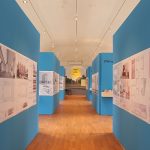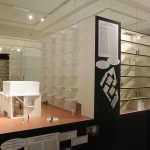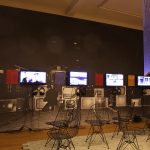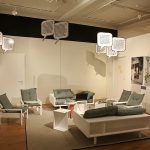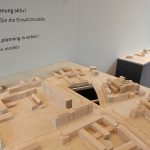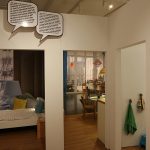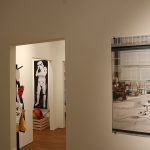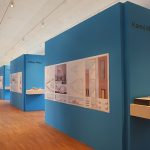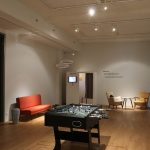Together. The new architecture of the collective @ the Grassi Museum für Angewandte Kunst Leipzig
Much as ever increasing co-working is altering understandings of and relations to work practises and office spaces, so to is ever increasing co-habitation altering understandings of and relations to domestic practises and spaces.
Albeit domestic understandings that are altering without as much public discourse as afforded those occurring in the workplace.
With the exhibition Together. The new architecture of the collective the Grassi Museum für Angewandte Kunst Leipzig explore, and thereby allow for a focus on, contemporary communal living.
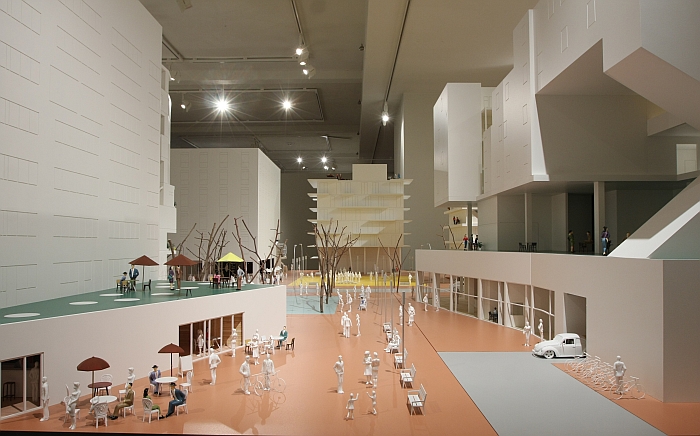
Poolhaus Vienna, as seen at Together. The new architecture of the collective the Grassi Museum für Angewandte Kunst Leipzig
Originally staged at the Vitra Design Museum in Weil am Rhein Together. The new architecture of the collective opens, as any competent analysis of contemporary society should/must with a review of past realities, specifically communal/collective housing past realties, be that communes, squats, decentralised communities, charitable projects or architectural proposals and including projects as varied as, and amongst a great many more, Charles Fourier’s Phalanstère from 1820 or Hull House Chicago from 1889 over the multitude modernist/functionalist era projects such as Le Corbusier’s Unité d’Habitation in Marseille with, amongst other features, its communal kindergarten on the roof, or Kollektivhuset in Stockholm by Sven Markelius & Alva Myrdal with its communal kitchens and dumb waiters, on to more contemporary projects such as Byker Wall in Newcastle, Co-op city New York, Oscar Niemeyer’s Edifíco Copan in São Paulo and Torre David in Caracas, as, arguably, one of the better recent examples of both the conflict between what people need and what architects build and also the way communal living can develop its own natural dynamic.
Having set the historical scene the principle part of Together is divided into two presentations: the first featuring large scale models of 21 international contemporary communal housing projects, models inter-twinned to create the impression of an integrated cityscape, and which although fusing effortlessly together allow for comparisons of the various proposals; and secondly a model communal flat in 1:1 scale which explains various aspects of communal living through on the one hand a series of photographs of communal housing interiors by Daniel Burchard and also through the voices of those who use such spaces, numerous quotes hanging in bilingual German/English speech bubbles above the various staged room set-ups. Staged room set-ups in a staged flat set-up which yes, means it does have the slight feel of IKEA; the difference being that no-one is trying to sell you anything, in many regards the fact that you are in the space means you’ve already paid your money, much more the intention is to try to encourage you to consider the pros and cons of communal living, and thereby develop/deepen your understanding of the contemporary context of communal living and by extrapolation your own position to such. A position a video booth at the end of the exhibition invites you to share with other visitors.
The final act of Together is a closer, more detailed, exploration of five of the 21 projects, a presentation which through films, documents, photos, sketches etc explains the practicalities of such arrangements. After which there is an invitation for a game of table football. Which yes, is in context and does make sense.
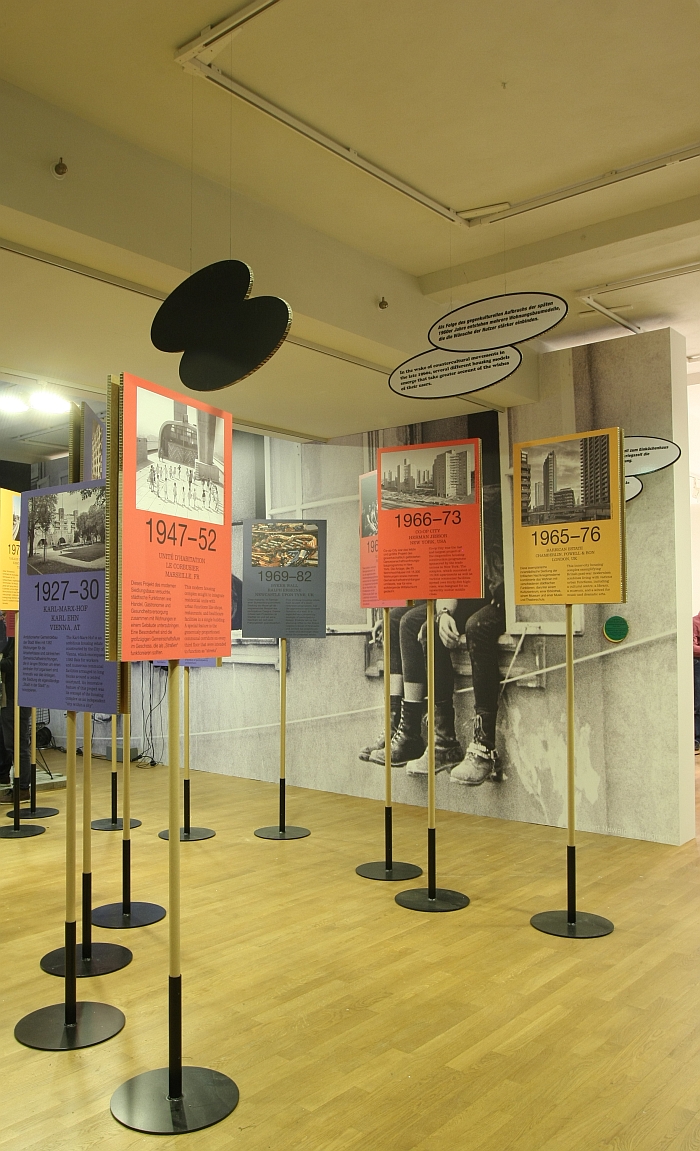
Utopia Now. Historic commual housing projects, as seen at Together. The new architecture of the collective the Grassi Museum für Angewandte Kunst Leipzig
While the compact, open, self-contained exhibition design combined with the short bilingual texts, and pleasing absence of architectural jargon, allow for easy access to the material, Together is an exhibition that involves a lot of work on the part of the visitor. Not a huge amount, don’t panic, as a subject it’s not particularly complicated, and as an exhibition Together explains and discusses more than it theorises and dissects; that said, it’s not an exhibition to plan to whizz quiuckly round, delighting as you go in the pretty objects, much more is an exhibition that demands you bring a little time and concentration with you. Do that and you’ll discover an easily comprehensible and logically constructed exhibition which while making the case for communal living, leaves you to decide if communal living is the answer for our domestic futures.
But, why should I do that?
We can’t believe you’re genuinely asking that! Because, and as we’ve oft noted in these dispatches, the future of our urban spaces is one for us all, they aren’t decisions we should be leaving to architects, designers or Californians alone, but ones with which we must all concern ourselves, be that questions of future mobility, future work, future shopping, future education or future housing.
Is the collective, communal model a future orientated solution?
A question returning to the historical review helps you consider, neatly underscoring as it does not only some of the less positive developments that can occur in context of such communal projects, but for all that although much of what is practised today was proposed, and practised, previously, it never achieved the popular acceptance it does now. A state of affairs which, arguably, is a reflection on our ever evolving society.
On the one hand, evolving demographics, be that an ever ageing population, an ever more single population, an ever more mobile, transient population, but ultimately demographic changes which mean that today there is an acute necessity to re-imagine how we organise our housing, the old models not always providing the answers we need; on the second hand, urban space is becoming ever more of a luxury, therefore decisions about what and how we build need to be taken with ever greater care; and on the rare, and therefore all the more valuable, third hand, evolving understandings of the personal/private, and also the way the evolving roles and functions of possessions are altering the way we relate to most everything that surrounds us. Whereas in generations past the life plan invariably involved, marriage, kids, career ladder, car, house, pension, death, these days it doesn’t necessarily, today social and health concerns play a more important role than the pure material, not for all, but for ever more, and a situation that, in all probability, will continue to develop exponentially in its current direction, and that as a, largely, technology driven evolution.
Does that make ever increased collective, communal living an inevitability?
Can/could/would you understand “home”, a sense of place, a retreat, in context of a collective, communal housing solution?
Or is that a position that puts too much value on the third hand to the detriment of hands one and two?
Together gives you the information, and for all the space, to consider your position. Which no, before you ask, isn’t a paradox; the physical space in the exhibition is communal, the space the exhbition creates in your thoughts is however very personal.
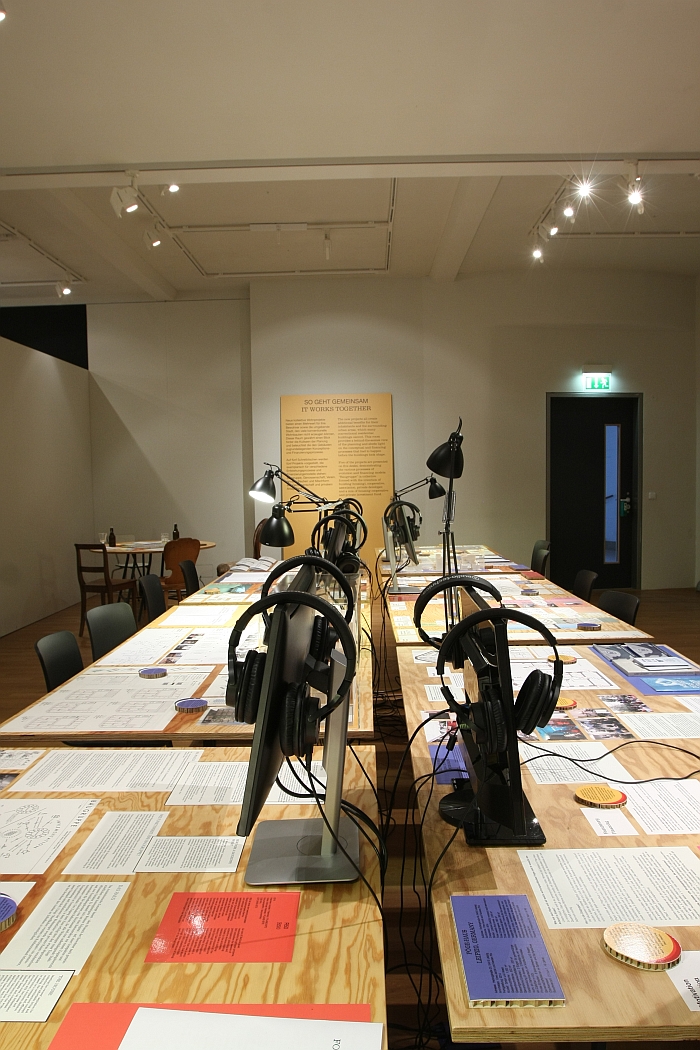
The deeper investigation of five communal housing projects, as seen at Together. The new architecture of the collective the Grassi Museum für Angewandte Kunst Leipzig
Rooting, if you will, the exhibition in Leipzig the Grassi Museum have extended the original Vitra Design Museum presentation with ten examples of local contemporary communal housing projects. A decision as pleasing as it is logical, because as a city Leipzig has a long history of communal living: two such projects, the Stiftung Meyer’sche Häuser from 1900 and the 1995 Alternative Wohngenossenschaft Connewitz eG are included in the opening historical review section; the latter being a nice reminder that the collective, communal, quasi-official, doggedly independent, plenum heavy, architect free, housing project was a defining feature of the city in the immediate post-unification years, and remains so, more or less, today; if of late the defiantly autonomous projects of yore have increasingly ceded to much more regulated, official, formally mortgaged, projects of very much the kind featured in Together. And a collection of projects, old and new, which neatly highlight the fact that in Leipzig you’re never that far from a communal housing project; and a post-unification spirit of self-responsibility that arguably also contributed greatly to the cultural and social development of the city, including the inevitable investor led gentrification that continues to do its best to stifle the spirit it purports to be able to sell you.
The Leipzig focus is very neatly continued in a second exhibition presented at the “end” of Together, Grassi Future, which presents ten Masters projects by architecture students at the TU Dortmund which concern themselves with proposals for a, theoretical, future extension of the Grassi Museum complex.
Grassi Museum für Angewandte Kunst Director Dr. Olaf Thormann was keen, very keen, to underscore that the projects represented theoretical proposals realised in context of an academic exercise, and that no plans were in place for any such development; however, the nature of the museum business means that institutions must by necessity physically expand, and the presentation of the Dortmund projects does feel like an attempt by the Grassi to, carefully and unhurriedly, initiate a debate. Not least on account of the way the Grassi Future pops-up, almost Guerilla-esque at the end of an exhibition (essentially) about future urban planning considerations. It’s an act very much in the finest Leipzig traditions. And something of which we thoroughly approve.
The Grassi museum complex has only very limited space into which it can develop, the biggest open area neighbouring it being a cemetery, and they tend to be excluded from building plans, and so the decision as to where and how the museum grows, as it will, must be careful made, and should only be made after proper discussion. All the Dortmund proposals concentrate on building on the grass triangle in front of the Grassi. But is that the only option? And if so how much land should it occupy? Should it echo the existing Grassi architecture or speak a new, independent language?
And so to anyone reading this in Leipzig, we can only recommend that you recognise the reality and start considering such, because it will come, and when it does it will change Johannisplatz, will change the views from Augustusplatz, will change the character of the area, and so it concerns all who live in the city.
You may not all live together, but you do all live together, and have a shared responsibility for the urban space if not necessarily for the cooking, cleaning and child care.
Together. The new architecture of the collective & Grassi Future run at the Grassi Museum für Angewandte Kunst Leipzig, Johannisplatz 5-11 04103 Leipzig until Sunday March 17th
Full details including information on the accompanying fringe and cinema programme can be found at www.grassimuseum.de
- Grassi Future, proposals for the further development of the Grassi Museum für Angewandte Kunst Leipzig
- Yokohama Apartment, Yokohama, Japan, as seen at Together. The new architecture of the collective the Grassi Museum für Angewandte Kunst Leipzig
- A collection of films, and Eames Wire Chairs, as seen at Together. The new architecture of the collective the Grassi Museum für Angewandte Kunst Leipzig
- A fictional communal housing project lounge, as seen at Together. The new architecture of the collective the Grassi Museum für Angewandte Kunst Leipzig
- The hole was the whole (focus) Grassi Future, proposals for the further development of the Grassi Museum für Angewandte Kunst Leipzig
- A fictional communal housing project flat, as seen at Together. The new architecture of the collective the Grassi Museum für Angewandte Kunst Leipzig
- Commual is all well and good, just be sure you know who you’re sharing with….
- Grassi Future, proposals for the further development of the Grassi Museum für Angewandte Kunst Leipzig
- It’s not every exhibition that invites you to a game of table football…..
Tagged with: Grassi Future, Grassi Museum for Applied Arts Leipzig, Leipzig, Together. The new architecture of the collective
